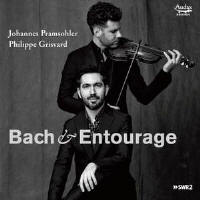Texte paru dans: / Appeared in: |
|
|
Reviewer: Robert
Maxham
Johannes Pramsohler (playing a
Pietro Rogeri violin from 1713) and Philippe Grisvard (playing a modern copy
by Christoph Kern of a harpsichord by Michael Mietke) have gathered together
a program of works written by composers in Johann Sebastian Bach’s orbit.
Pramsohler draws a stentorian, trumpet-like tone from his violin in the
first sonata, which has been attributed variously to Bach and to his
acquaintance and violinistic model, Johann Georg Pisendel. Together,
Pramsohler and Grisvard realize much of the first movement’s fantasy, spun
out with dramatic chromaticism, before moving to the second movement, a
Presto that sounds very Bach-like, even when chromatic sequences eventually
dominate the harmonic conversation. Pramsohler sounds particularly affecting
in the Affetuoso, in which he drapes languid lines above Grisvard’s active
harpsichord part, and more straightforwardly joyous in the concluding Vivace.
The five movements of the
anonymous Sonata in A Major, BWV Anh II 153, begin with an adventurous
Andante that seems somehow less dense than the corresponding movement in the
C-Minor Sonata. So, too, the ensuing Allegro, which, though it swirls like
the violin solos in Bach’s Fourth Brandenburg Concerto, also seems more
straightforward. Once again, Pramsohler and Grisvard draw as much of the
Affekt from the slow movement as can be extracted, although they can’t bring
more coherence to the middle of the movement than the composer brought to
its creation. After another Allegro, buoyant in the duo’s reading, the final
movement, a fugue, allows Pramsohler to explore the upper registers of his
violin virtuosically. Pisendel also concentrated the virtuosity he had perhaps absorbed from Vivaldi, this time in a solo sonata that seems very different from Bach’s own works in the genre—more monodic, though with a generous sprinkling of double-stops, and riding on the rails of rhetorical gestures in the first movement. Pramsohler hardly makes the last movement’s technically difficult Giga and variations sound easy.
The Sonata in C Minor by
Johann Ludwig Krebs may fill out the form of the more gallant works of the
generation following Bach’s, but it seems in its Grave more affecting than
commanding and to engage in note-spinning in the last movement (of three:
slow, fast, and faster). Pramsohler’s recording purports to be the first of
this work. Johann Gottlieb Graun’s sonata, on the other hand, bears traces
of the Italian elegance of one of his teachers—Giuseppe Tartini—in its first
movement, an influence of which Pramsohler takes effective advantage; but
Graun surpasses the virtuosity not only of Tartini but of Pisendel, with
whom he also studied. Whatever virtuosity the first three movement exhibit,
the last, a rollicking Allegro, sweeps everything that went before it away
in its sheer exuberance, to which Pramsohler adds a sizzle all his own. The
program closes with Bach’s Fugue in G Minor, another sweepingly virtuosic
work that sounds, with its accompaniment, less tightly wound than at least
two of the fugues (in G Minor and A Minor) in the composer’s solo sonatas
and partitas. Although he plays on a period instrument, Pramsohler brings to these works the kind of sunshine that Arthur Grumiaux radiated on works from the period. The ambiance of the studio in which the musicians recorded gives the sonic impression of a large, reverberant space like that of a church. Strongly recommended. | |
|
|
|
|
|
|
|
Cliquez l'un ou l'autre
bouton pour découvrir bien d'autres critiques de CD |
|




